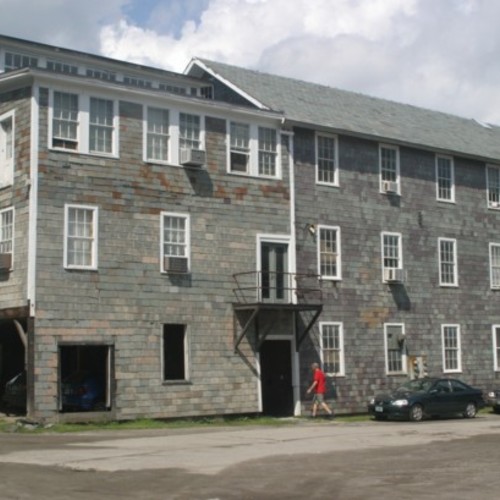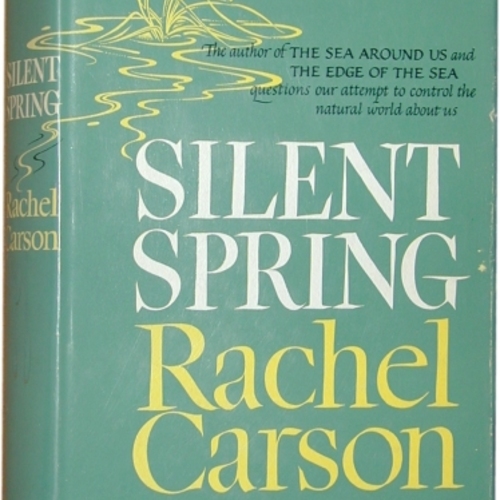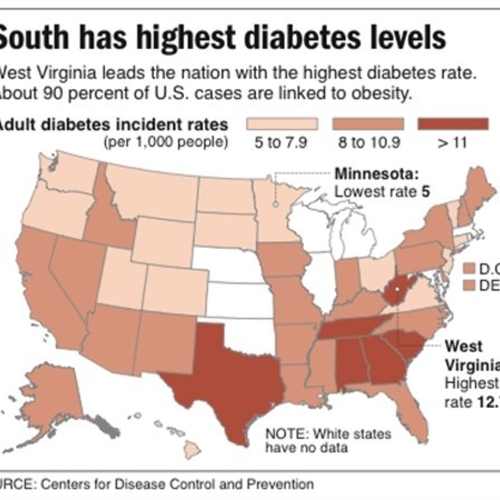Image Credit: Alex Wilson
Image Credit: Alex Wilson Mulching newly planted fruit trees with the Kubota tractor I found on Craigslist a couple of years ago.
Image Credit: Alex Wilson I put in about a quarter-acre of heirloom pumpkins that a local brewer wants for his seasonal beers this fall along with some other crops.
Image Credit: Alex Wilson
Transitions.
Back in June, 2008 I started writing a weekly column on energy for the Brattleboro Reformer, our local newspaper. I thought it would be fun to write a regular column on a topic that I’ve focused so much time on over the past 35-plus years. I was pretty confident that I could come up with enough topics to crank out a year’s worth of columns, and I thought some of the Reformer’s readers would appreciate such a column — geeky as it might be.
Somewhat to my surprise, the editor said sure, and I’ve been writing the weekly Energy Solutions column ever since — except during an eight-month period in 2011 when I was on sabbatical from BuildingGreen and needing the freedom to travel and focus on launching the nonprofit Resilient Design Institute.
For much of that time I’ve been posting these musings as blogs for BuildingGreen.com and Green Building Advisor. That’s been a bit of a challenge, because I’ve tried to write the column/blog to serve both a lay audience and practitioners. This has led to occasional complaints by the newspaper readers that it’s too technical and complaints by blog readers that it’s too simplistic.
But mostly I’ve been able to find that balance to have some content appropriate for everyone. (I also often tweak my columns before posting online to ad a bit more detail.)
This is my 273rd column/blog. At about 900 words per, that’s nearly 250,000 words (20% more words than Herman Melville’s Moby Dick).
Moving on
While there is lots more that could be said about energy, I’m feeling a need to move on. With spring here I’m wanting to devote my weekends to creating the farm in Dummerston that I’ve alluded to now and then in my blogs.
I also want more time for other creative endeavors. Writing the Energy Solutions blog has been a regular part of my weekend these past five-plus years — just ask my wife, Jerelyn! Usually it isn’t a huge amount of time — typically one to three hours (sometimes considerably more) — but it takes a lot to come up with topics that can be presented in a way that’s understandable to a lay audience and also informative to building professionals.
I’m also wanting to devote more of my creative energy to writing about resilient design and build more of a reader base on ResilientDesign.org. I’ve been wanting to post articles more regularly on ResilientDesign.org, but I just don’t find the time. I need to change that.
I’ll miss the feedback and questions
In saying goodbye to my Energy Solutions blog, I’ll miss the reader comments. Well, maybe I won’t miss the comments from climate change deniers who continue to flail away at their stubbornly held beliefs that humans aren’t the cause of the changing climate we’re now experiencing. I’ll even (sort of) miss the calls and e-mail queries I’ve gotten pretty regularly since starting the column. Many of those start with something like, “Alex, I’ve been thinking of adding insulation to my attic…” or “our boiler is on the fritz and we’re thinking of…”
I consider myself an educator, so I like being able to help people out. I also like the fact that those people I’m reaching — either through the column or through follow-up calls — are reducing their energy consumption, contributing less to climate change, and in many other ways helping create a better environment.
But I’ll be glad to dial it back a bit.
Parting thoughts on energy
If I can leave you with a few take-away thoughts on energy it is these:
- Start with energy conservation. While not as glamorous as solar panels on the roof or a plug-in hybrid in the driveway, energy conservation is usually the smartest choice. Add insulation to your house (or that of your clients) so that the furnace or boiler doesn’t have to work as hard; build smaller so you’re heating and cooling less space; combine driving trips or ride a bicycle to reduce the need for your car; wash your clothes in cold water. A kilowatt-hour or gallon of heating oil saved is usually cheaper than one that is consumed even with the highest efficiency equipment.
- Implement passive solutions. When it comes to house design, rely on passive solar design, passive cooling strategies (such as overhangs to shade windows), and natural daylighting strategies to reduce the daytime needs for electric lighting.
- Install high-efficiency equipment. Once loads have been reduced and passive systems have been incorporated to the extent possible, install high-efficiency mechanical systems (furnaces, boilers, water heaters, lighting equipment, appliances), water-conserving plumbing fixtures (low-flow showerheads can dramatically reduce water heating costs), and consider fuel economy with your next car purchase.
- Rely on renewable energy. Most renewable energy systems are still fairly expensive, so it makes sense to practice conservation first. But then, by all means, look to solar-electric (photovoltaic) modules for your electricity. Wind energy only makes economic sense on a larger scale — usually with off-shore or ridge-top installations of multiple, large turbines — but in the right location wind power is the most cost-effective renewable electricity generation option we have today. On-farm methane generation, biomass co-generation systems, and technologies like tidal power and wave power should all be considered in our efforts to move away from carbon-intensive fossil fuels.
It has been a lot of fun to write this blog, and I suspect I’ll contribute an occasional piece. But, meanwhile, those interested in following my other writing can either sign up to get e-mail notices when I post articles on ResilientDesign.org, or sign up for my Twitter feed (where I let followers know about articles I’ve published or posted). Archives of most of my columns can be found as the Energy Solutions blog on BuildingGreen.com or Green Building Advisor.
Thanks for reading my blogs, challenging me when I’ve veered too far into the world of conjecture, and being part of the conversation. Keep in touch.
Alex is founder of BuildingGreen, Inc. and executive editor of Environmental Building News. In 2012 he founded the Resilient Design Institute. To keep up with Alex’s latest articles and musings, you can sign up for his Twitter feed.
Weekly Newsletter
Get building science and energy efficiency advice, plus special offers, in your inbox.
















16 Comments
Many Thanks
I appreciated your time and effort here writing excellent articles that have been a great help to me. Good luck and continued success in any and all future endeavors.
Regrets
It is unfortunate that you still find it necessary to offer a gratuitous insult ("climate change deniers") to the many honest and well-informed people who do not choose to share your evidence-free belief that recent increases in anthropogenic carbon dioxide are the direct and sole cause of future catastrophic global warming, AKA climate change. You are one of the good guys, writing interesting articles on important topics. If you have hard evidence that modest increases a beneficial trace gas in our atmosphere is going to lead inexorably to disaster, let's hear it. Hand waving does not count.
Good luck in your future enterprises.
Tony.
Tony,
I think time (2014 through 2021) has pretty much, very much, shown Alex to be correct about climate change and you to be incorrect. Evidence: thermometers around the world, worse wildfires, worse heat waves, more severe storms & floods, record warm winters, etc.
Since 2016, the temperature trend has been slightly downward. Look it up on gov website. Anyway, I find it difficult to base conclusions and long-term decisions on such limited data, timewise, for either side of the argument. Name-calling ("deniers") only complicates the discussion, however, and discourages healthy debate, which is how we learn. The phrase "settled science" is an oxymoron.
"healthy debate" happens among real scientists, not random commenters on various internet commenting boards that have declared themselves competent by way of being able to type and having a political preference.
Climate change
Tony, I'm a scientist by background--biology--and, like other scientists, base decision making on evidence. I have followed climate change research since the mid-1970s and actually still have reports suggesting that global COOLING may be occurring (fascinating information on the conflicting anthropogenic forces at work: particulates that were then through to result in reduced solar gain on earth and greenhouse gas emissions that would trap heat). One of those papers (from 1976 I think) suggested that the direction of climate change would depend on which of those forces became dominant. I say this to point out that top scientists have been on both sides of the climate change debate, so I am sympathetic to those who doubt that anthropogenic factors are changing the climate.
But over the past two decades, the vast majority of scientific opinion opinion has shifted to the global warming side--that anthropogenic climate change is occurring. As I have said in a previous blog, if 98 doctors tell me that I have cancer and two say I don't, I'm going to listen to the 98 and, based on that information, do something about it. I believe that is where we are with climate change today. The evidence I look at, such as that footnoted in the recent IPCC report, is very clear. As someone trained in science, I can't in good conscience ignore that data.
Thank you!
Alex,
Aside from your insights, it was refreshing to know which side of the climate change fence you sat on: the science side. As a Canadian, its stunning to me that there's "debate" in the US. I thank you for being frank, writing about it and taking the hits from the fringe graciously. Love your analogy for the lay audience: "if 98 doctors tell me I have cancer..." that's what sets you apart in being able to connect with the audience.
Best wishes!
Resilient design and Oreo cookies
Lets just say... Nice house.
Alex, your first two bullets aren't happening much.....
.........except as sloooowly mandated. Many people think they are too elite to recognize that the sun is the source of our energy, and that it's best for us to use it as passively as possible. We like to emulate nature so much, but I don't know of any living thing that deliberately burns anything to survive. No, I'm not saying we shouldn't burn anything, but we should try harder to be like nature and use the sun more passively. I mean, you can't hardly even buy windows anymore with SCGC > 0.5. Hundreds of thousands of people are installing PV because it is subsidized/cheap, and could care less about first or simultaneously considering energy conservation or other passive solar design.
I haven't read much of anything you've had on this site. But this GBA site in other areas hasn't been all that "green" with respect to your first two bullets, presumably important to you.
Response to Sonny Chatum
Sonny,
I'm surprised that you wrote, "This GBA site in other areas hasn't been all that green with respect to your first two bullets [energy conservation and passive strategies]."
This comment left me scratching my head, because GBA has published hundreds of articles on these topics. But then I figured it out; you also wrote, "I haven't read much of anything you've had on this site."
Martin you are wrong, again, on two levels
First, GBA has had very minimal coverage on passive solar, opting rather to support modern windows, with little or no SHGC, so that passive solar is, right there, automatically put on the back burner. You argued with me about calculations of solar contribution, even though it is a relatively trivial calculation to do for anyone with any technical qualifications at all.
Second, you didn't even get my quote right. I said that I haven't read much of what Alex has written. In fact, I have read quite a bit on the GBA site.
Martin is writ[ing] again, on more than two levels
I don't know Sonny, and he is entitled to his experience and viewpoint, but as an avid reader of Green Building Advisor, my experience is that Martin continually writes about most of the right building stuff. By "right", I mean the issues that make a difference and have practical value for energy and resource conservation on multiple levels, as related to the building field.
I haven't done a statistical analysis of Martin's articles, but I just spent an hour looking at his most recent three, and a fairly recent one on windows, since Sonny mentioned Martin's window treatment as a negative. The most recent article that I found is on Universal Design. Although this topic doesn't have an obvious tie-in with Alex's list, I counted nine explicit references to energy conservation issues, and it features a link whose title directly highlights energy conservation. Martin's next most recent article is "Vermont House Uses Only Half a Cord of Firewood". I only found one (brief) paragraph that didn't say something related to energy conservation. Moving backward in time, "New Green Building Products — May 2014" mentions roughly ten products, including the five featured items, and five others compared to them. All ten are related to energy conservation.
Windows got, at most, passing reference in these articles. I didn't find a good way to use GBA's search feature to find the most recent article on window selection criteria. [The dates listed for articles in the search results don't always correspond to the date on the article, for example, "Solar Thermal is Dead" is shown in the search results with a date of 5/16/2014, but it is really from 2012, and it doesn't indicate an update has been applied, as at least some updated articles do. It's also odd that this article came up in the search for "windows", since the word doesn't appear in the article, and only once in the comments.] I did find an article from 2010, titled "Choosing Triple-Glazed Windows". That seems like a title of an article, whose content could bolster the contention, that Martin either ignores Solar Heat Gain Coefficient (SHGC), or tolerates/supports windows with "little or no SHGC".
However, this article places high attention and importance on SHGC. The subtitle is "Balancing U-factor and solar heat gain". The first heading is "Look for a low U-factor and a high SHGC". Two other early paragraphs begin, "Most cold-climate builders want windows with a high solar heat gain coefficient", and, "Most low-U-factor windows have a SHGC that is unacceptably low". As you might suppose from these quotes, the whole article is focused on the importance of a high solar heat gain coefficient for many windows used in cold climates.
Martin's writing for GBA meets my needs very well, for discovering, learning about, and understanding green building topics, including energy conservation and passive strategies. As a long-time reader, my impression of GBA content is the opposite of the one Sonny expresses, and my not-so-quick analysis of these four articles supports my impression.
In addition to his articles, Martin manages the GBA website with a good balance of diversity, quality, and relevance, via articles from many authors. I'm glad that he has included Alex Wilson's articles during the five years that Alex has been cross-posting some of his articles for the Brattleboro Reformer to GBA. I hope we continue to see Alex's name on GBA frequently. Thanks, Alex, for your contribution to my personal storehouse of information and education.
Alex, I'm signed up to get notices of new Resilient Design posts
I happily await your next musings!
Response to Sonny Chatum
Sonny,
You wrote, "GBA has had very minimal coverage on passive solar, opting rather to support modern windows, with little or no SHGC."
In fact, I have been chastising U.S. window manufacturers for a dozen years on the fact that high-solar-gain windows are hard to find, and have strongly urged these manufacturers to promote high-solar-gain options for the northern half of the U.S.
For example, see my article, High-Solar-Gain Glazing.
GBA
I have learned alot from the site, thank you! I struggle to find articles on "Natural Building" in the "green" chapter of tight homes. To me it makes no sense to trap toxins into a home and there are lower cost solutions than wood and concrete. I've studied mainstream not for me; cob, adobe bricks, rammed and poured earth, straw bale, earth plasters, floors, etc.....Getting ready to finalize the design and break ground soon as I run some test, leaning towards poured earth, bales, perhaps a hybrid. Not sure what to do with the roof.....maybe poured earth using concrete techniques. I tried permies.com but got tired of the rest of world bashing America for poor construction methods and so called 'green', bashed by some native Americans even. I actually got banned for defending America stating that permies were not around 1000 years ago to prove the China Wall is better than our 40 year structures, but some bale homes are still standing in NE. Just called the NE Governor's office to get in tough with the right person to help the Pilger tornado clean up effort, and go in there as an Design Engineer to see what and how I can design ballistic tornado proof homes to save lives. I think I have the earth massive walls figured tbd, just not sure how to strap down the roof. Perhaps I can find some help with FEMA I don't know. Not sure what is causing it but they seem to be getting worse, this one killing a little girl.
I'm also stopping by Chicago along the way to pick up a few bags of building hemp, run some test.
Anyway there are some subjects I like to see more of and good luck Alex thanks for the educations.
Response to Terry Lee
Terry,
Here are some links to articles that you may be interested in:
Natural Building In Nicaragua
Straw-Bale Walls
Nostalgia for the Hippie Building Heyday
Low-Road Buildings Are Homeowner-Friendly
Energy-Efficient Straw-bale Home in the Colorado Rockies
<a
Log in or create an account to post a comment.
Sign up Log in